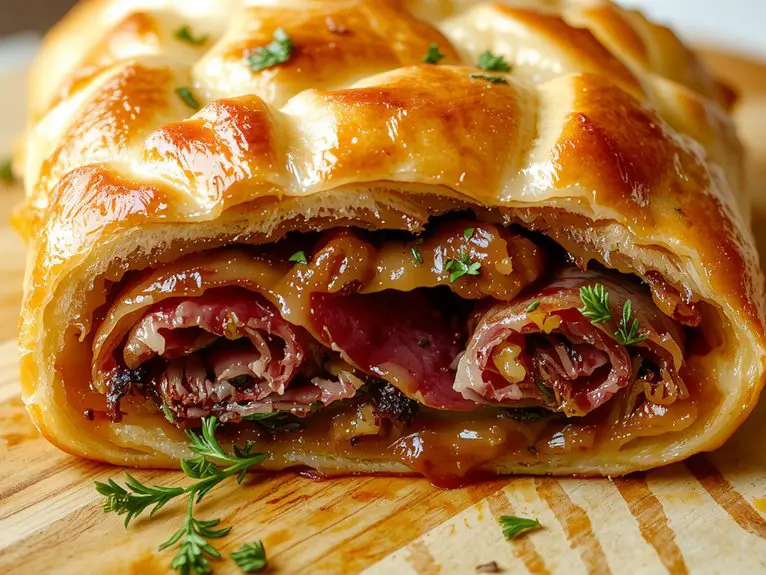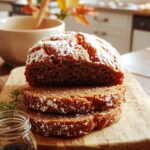I’ve spent years perfecting the art of making a truly exceptional Beef Wellington, and it all comes down to a few key steps that elevate this dish to a crowd-pleasing masterpiece. From the perfectly seared beef tenderloin to the layers of mushroom duxelles and prosciutto, every detail matters. If you’re ready to impress with a dish that’s as elegant as it is flavorful, there’s something here you won’t want to miss.
Recipe
I can confidently say this Beef Wellington recipe is a showstopper that will leave your guests in awe—it’s the kind of dish that feels fancy but is totally doable with a little patience. What makes it special? The perfect sear on the beef, the rich umami of the duxelles, and that golden, flaky puff pastry wrapping it all together.
I’ve made this countless times for holidays and family gatherings, and it’s always a hit—seriously, it’s worth the effort. Imagine this: tender beef cooked to juicy perfection, surrounded by a layer of earthy mushrooms and prosciutto, all encased in a buttery crust that shatters with every bite.
Trust me, once you try it, you’ll never look at special occasion meals the same way. Let’s get cooking!
Ingredients
Achieving the perfect Beef Wellington starts with high-quality ingredients that work together to create layers of flavor and texture. Here’s what you’ll need to craft this iconic dish, along with some chef-approved tips and swaps to make it your own:
– Beef Tenderloin (Center Cut): The star of the dish—opt for a center-cut piece for even thickness and tenderness. Ask your butcher to trim it for you to save time.
*Pro Tip:* Let the meat come to room temperature before searing for even cooking.
– Dijon Mustard: Brushed on the seared beef, it adds a tangy depth that balances the richness of the pastry.
*Substitution:* Grainy mustard works too, but avoid yellow mustard—it’s too overpowering.
– Mushrooms (Cremini or Button): Finely chopped for the duxelles, they add earthy umami flavor.
*Pro Tip:* Cook them slowly until all the moisture evaporates—this guarantees your pastry stays crisp.
- Shallots: Adds sweetness to the duxelles. Substitute with yellow onions if needed, but shallots are worth the effort for their delicate flavor.
- Fresh Thyme: Lends herbal brightness. Dried thyme works in a pinch, but fresh is ideal for a more aromatic profile.
- Prosciutto or Parma Ham: Acts as a moisture barrier and adds a salty, savory layer.
*Pro Tip:* Lay the slices slightly overlapping to guarantee full coverage.
– Puff Pastry: Store-bought is fine, but make sure it’s high-quality and thawed properly for easy handling.
*Non-Negotiable:* Use butter-based puff pastry for superior flavor and flakiness.
– Egg Wash (1 Egg + 1 Tbsp Water): Essential for that golden-brown, glossy finish.
*Little Win:* Add a pinch of salt to the egg wash for extra shine.
- Sea Salt & Black Pepper: Season generously—these simple ingredients amplify all the flavors.
- Optional: Truffle oil or pâté can be added to the duxelles for a luxurious twist, but they’re not necessary for a classic Wellington.
With these ingredients and tips, you’re well on your way to mastering a Beef Wellington that’s as impressive as it’s delicious.
How to Make the Best Traditional Beef Wellington Preparation

Prepare the beef tenderloin:
Trim any excess fat or silver skin from the tenderloin, and season generously with salt and pepper. Sear it in a hot skillet with oil until evenly browned on all sides—this locks in flavor and creates a crust.
Let it cool completely before wrapping; wrapping it warm will melt the pastry later.
Prepare the duxelles:
Pulse mushrooms, shallots, garlic, and thyme in a food processor until finely chopped.
Sauté the mixture in a pan until most of the moisture evaporates—this prevents soggy pastry later.
Spread the duxelles on plastic wrap and let it cool.
Layer the prosciutto and mustard:
Lay overlapping slices of prosciutto on plastic wrap, creating a rectangular sheet.
Spread a thin layer of Dijon mustard over the cooled beef—this adds tang and enhances the flavors.
Roll the beef in the prosciutto, wrapping it tightly to seal.
Wrap in puff pastry:
Roll out thawed puff pastry into a rectangle large enough to envelop the beef.
Brush the pastry with egg wash (beaten egg with water) to help it stick and brown beautifully.
Place the wrapped beef in the center, fold the pastry over, and seal the edges tightly—trim any excess for a neat finish.
Chill before baking:
Refrigerate the wrapped Wellington for at least 30 minutes.
Chilling firms up the pastry, ensuring it holds its shape and bakes evenly.
Preheat the oven to 400°F (200°C) during this time.
Bake and rest:
Brush the pastry with another layer of egg wash for a golden finish.
Score the top lightly with a knife to prevent air bubbles.
Bake for 25-30 minutes, or until the pastry is golden brown and a meat thermometer reads 120°F (49°C) for medium-rare.
Let it rest for 10 minutes before slicing—this allows the juices to redistribute.
Slice and serve:
Use a sharp knife to cut thick, clean slices.
Serve immediately for the best texture and flavor.
Pro tip: Let everyone admire the perfectly pink center before digging in!
Nutrition
Understanding the nutritional information of Homemade Beef Wellington can help in maintaining a balanced diet.
| Nutrient | Amount per Serving |
|---|---|
| Calories | 520 |
| Total Fat | 32g |
| Saturated Fat | 12g |
| Cholesterol | 105mg |
| Sodium | 480mg |
| Total Carbohydrate | 25g |
| Dietary Fiber | 2g |
| Sugars | 2g |
| Protein | 32g |
Chef Tips
While making Beef Wellington can seem intimidating, I’ve found a few tricks that make the process smoother. First, I always sear the beef to lock in juices and chill it before wrapping to prevent overcooking.
I use a thin layer of mustard for added flavor. Rolling the pastry tightly guarantees even baking, and scoring the top helps it puff beautifully.
Resting before slicing keeps it moist and perfect.






